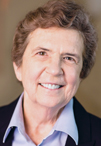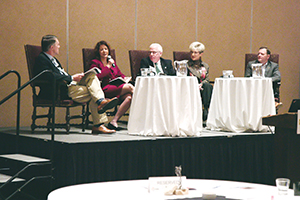By JUDITH VANDEWATER

Sr. Carol
ALBUQUERQUE, N.M. — Mission and human resource executives and senior leaders responsible for organizational learning and development came together at CHA's System Mission Leadership Forum here in late February to learn how peers are breaking down silos within health care organizations in order to better recruit, train and inspire a workforce to advance the mission and goals of Catholic health care.
CHA convened the invitation-only meeting having heard from mission officers that they are seeking ways to participate in important decisions about strategy, budget, the hiring of key leaders in their organizations, and discussions that set the expectations and foundations for mergers, acquisitions and partnerships. Mission leaders maintain these decisions are foundational to mission effectiveness and to nurturing a flourishing, unified culture. Seventy-six executives and managers from 19 health systems participated in the forum.
Sr. Carol Keehan, DC, CHA's president and chief executive officer, told the audience that ministry sponsors and chief executives recognize that the mission role is central to the vitality of the Catholic health ministry. "You are responsible in many ways with assisting the CEO with (creating and preserving) the soul of the operation, and the soul impacts everything," she said.
Brian Smith, CHA's senior director of mission innovation and integration, assured the audience that in their most recent convenings, the CHA Board of Trustees and sponsors of Catholic health ministries made clear that they recognize the urgent need to create a pipeline of trained and committed people to fill jobs in pastoral care, ethics and mission. CHA has undertaken a ministry-wide initiative to identify core competencies for mission professionals and other tools that members can use to recruit, develop and retain a pool of talent for hard-to-fill jobs in chaplaincy, Catholic ethics and mission.

CHA's Brian Smith, left, moderates a panel of senior mission leaders at the association's System Mission Leadership Forum in Albuquerque, N.M. Panelists, from left, are Elizabeth Keith, CommonSpirit Health's executive vice president of mission; Philip J. Boyle, Trinity Health's senior vice president of mission and ethics; Mary Hill, Avera Health's executive vice president of mission; and Timothy L. Glover, Ascension Health's senior vice president of mission integration. Smith is CHA's senior director of mission innovation and integration.
True north
While the role of mission leaders — and their position on organizational charts — varies from system to system in Catholic health care, typically the chief mission officer oversees ethicists, mission personnel who work at the system, region and community level and pastoral care providers. While a nonprofit's chief executive holds the ultimate responsibility for carrying out an organization's mission, mission leaders are charged with infusing mission into every aspect of their organizations and with preventing mission drift. And they must accomplish this through soft influence rather than executive dictums.
Some mission executives working at the regional and hospital levels also have broad portfolios that include oversight of service lines that are not traditionally considered mission functions.
Fr. Dennis Holtschneider, president of the Association of Catholic Colleges and Universities, said health systems still are learning when and how to use mission leaders. Fr. Holtschneider, who until recently was executive vice president and chief operations officer for Ascension Health, said given the pace of change in health care, a coherent mission structure and strategy is critical if the Catholic health ministry is to keep its "true north."
Importantly, he said, mission departments must continue to adapt to changing delivery systems. This means serving patients and staff in ambulatory care sites, home health care, nursing care and medical practices as well as hospitals. "The passivity of simply continuing work that the world doesn't need us for anymore while ignoring new needs is perhaps the most unnoticed of ways that organizations lose their ways," Fr. Holtschneider said. "In the midst of chasing opportunities — and viability — how do we keep an organization always asking 'Who's vulnerable and suffering? Who is not being served? Who no longer needs help?'"
Natural allies
Fr. Holtschneider said mission leaders, human resources executives and organizational development executives sit "at the intersection of big ideas and implementation" of those ideas. All have a role to play in making sure that employees feel motivated and engaged, and find fulfillment in their work, which makes them natural allies in the workplace.
Another shared goal is to have employees take ownership of a system or facility's Catholic identity.
Teams from Avera Health and CHI Franciscan Health gave back-to-back presentations at the two-day meeting describing how mission, human resources and organizational development staff partner in their respective organizations. They described tactics to reach frontline managers and employees in ways that promote staff well-being and mission buy-in while advancing care quality, safety and patient satisfaction.
'Be bold and confident'
A panel of senior mission leaders offered examples of how they go about getting mission personnel seats at the tables where planning, strategy and operations are discussed. The panelists said it is important to demonstrate — through relationship building and hard data, when possible — how mission can advance organizational strategies and goals.
"Be bold and confident. Insert yourself in situations where you can be a key mission voice," Elizabeth Keith, executive vice president of mission for CommonSpirit Health, urged the audience. Keith was executive vice president of sponsorship and mission integration for Dignity Health before the system merged with Catholic Health Initiatives in January to form CommonSpirit.
She shared the dais with Philip J. Boyle, senior vice president of mission and ethics for Trinity Health; Timothy L. Glover, senior vice president of mission integration for Ascension Health; and Mary Hill, executive vice president of mission for Avera Health. Smith moderated the session. The panelists described the steps they took or are taking to ensure that mission gets the budget and human resources deemed necessary to success.
Boyle said Trinity's mission department is about 16 months into a comprehensive reorganization that he expects to be completed next year. A central question posed at the outset was how the mission department could further Trinity's strategic aim of performance excellence. The answer in part involved getting mission services' voice into the planning cycle of every major part of health system operations, including work to advance quality and patient satisfaction, communications and human resources, he said. "We developed a breakthrough strategy in mission and created councils" made up of mission leaders and people from an array of disciplines and departments.
Boyle said to preserve mission resources for maximum impact, managers analyzed all tasks assigned to mission personnel at all levels of the organization. The goal was to identify essential and nonessential mission tasks. He said that over the years chief executives had assigned mission leaders tasks such as managing food service and gifts shops that, while essential to the organization, did not belong in the mission wheelhouse.
Mission critical
Like Trinity, Ascension is moving from a holding company to an operating company structure. Glover said it's been important to craft and revise system-level and administrative policies to codify that mission integration is an essential part of being a Catholic organization. Budgets must reflect that, he said, and mission departments must spend money efficiently and in a manner that adds value and improves patient outcomes.
He offered Ascension's spiritual assessment tool as an example of how this is achieved. He said the tool can recognize spiritual distress and point to patients who could benefit from research-based interventions. "Instead of just doing the 'howdy rounding' in acute care, we will go right where we are needed and bring that board-certified expertise."
Hill said Avera never has questioned the need for mission representation at the system level. She attributes this in no small part to the ongoing active involvement and presence of Avera's two sponsoring congregations, the Benedictine Sisters of Yankton Sacred Heart Monastery and the Sisters of the Presentation of the Blessed Virgin Mary of Aberdeen, S.D. "Four of our six mission leaders are sisters or have been. We have at least 50 of the sisters who serve on boards and are involved in sponsorship," she said.
The last segment of the forum followed a table conversation format. Participants shared ideas on the competencies needed by mission professionals in entry-level, mid-career and leadership roles and how they might want to structure the work of mission integration going forward to address the changing realities within Catholic health care. CHA's Smith said some participants discussed including succession planning and talent development initiatives in their upcoming budgeting conversations to ensure their ministries will have a pipeline of qualified mission leaders, ethicists and chaplains. "This ministry-wide (staffing) challenge requires a ministry-wide response," said CHA's Smith.